Answered step by step
Verified Expert Solution
Question
1 Approved Answer
Luster The appearance of a mineral's surface in reflected light is its luster. Light reflects from the outermost surface of a mineral lattice to
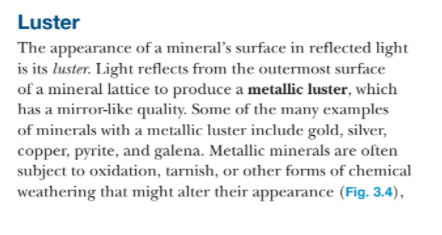
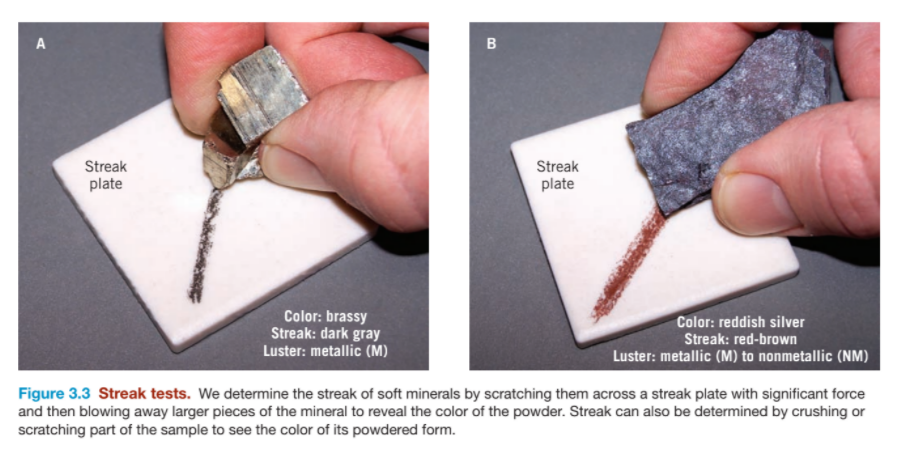
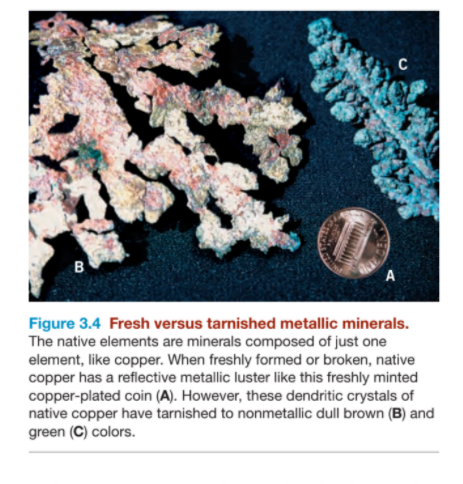


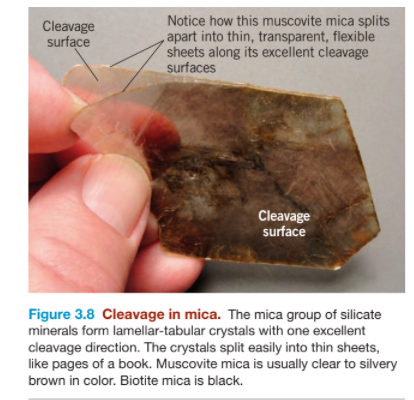
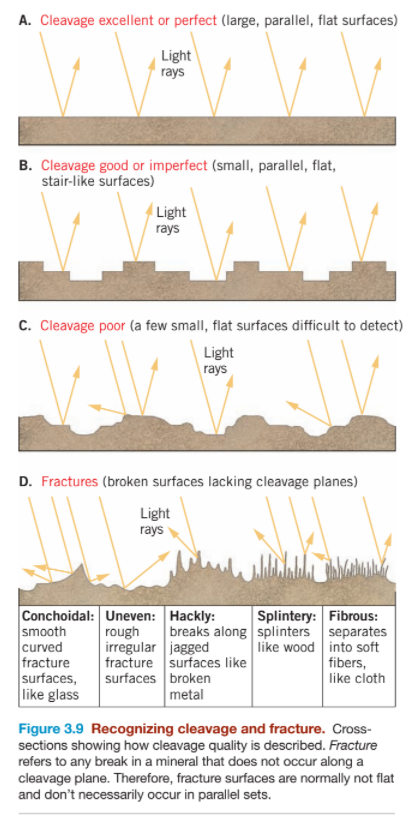
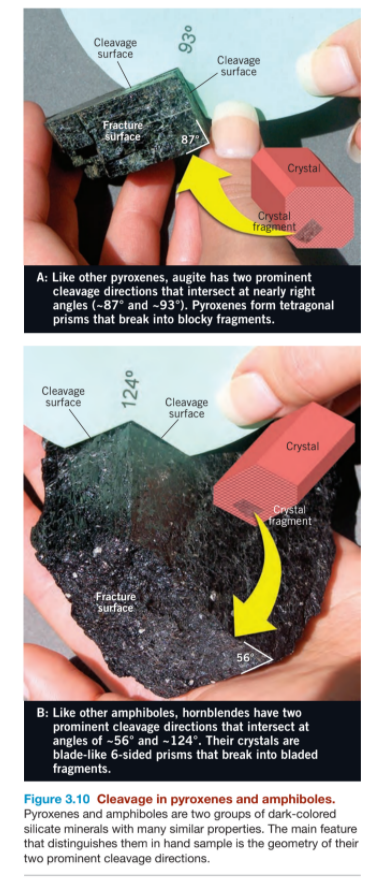
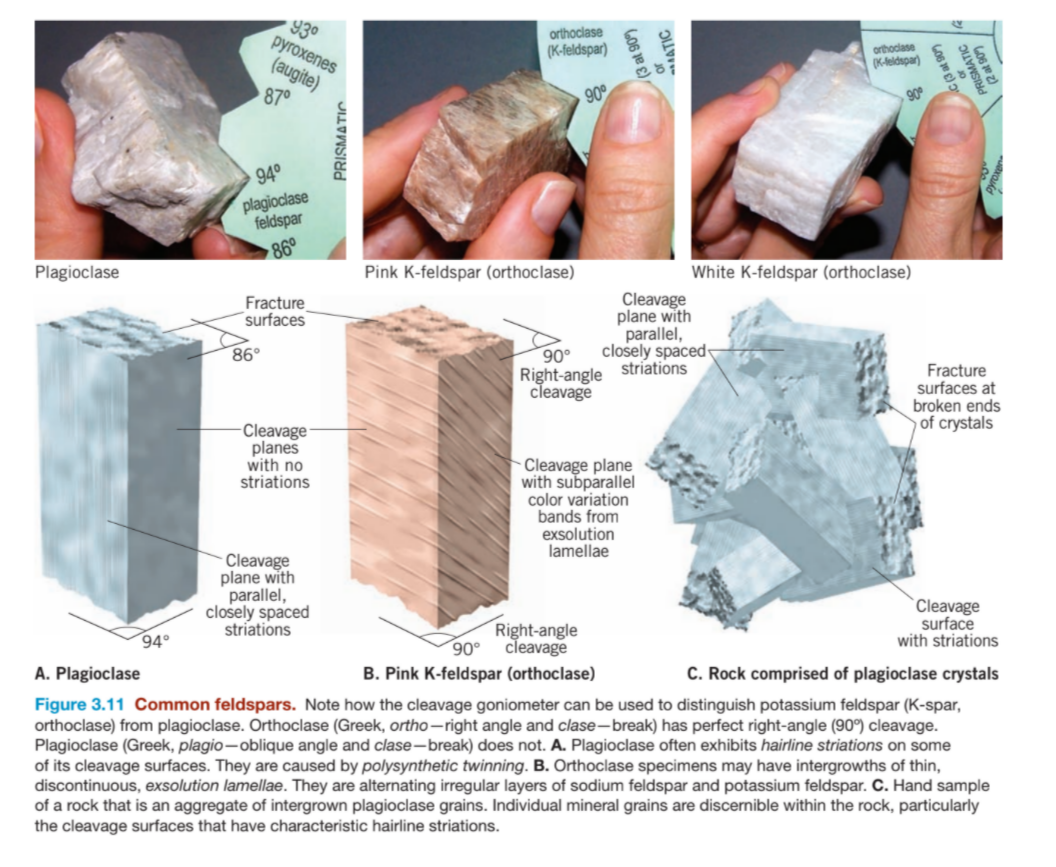
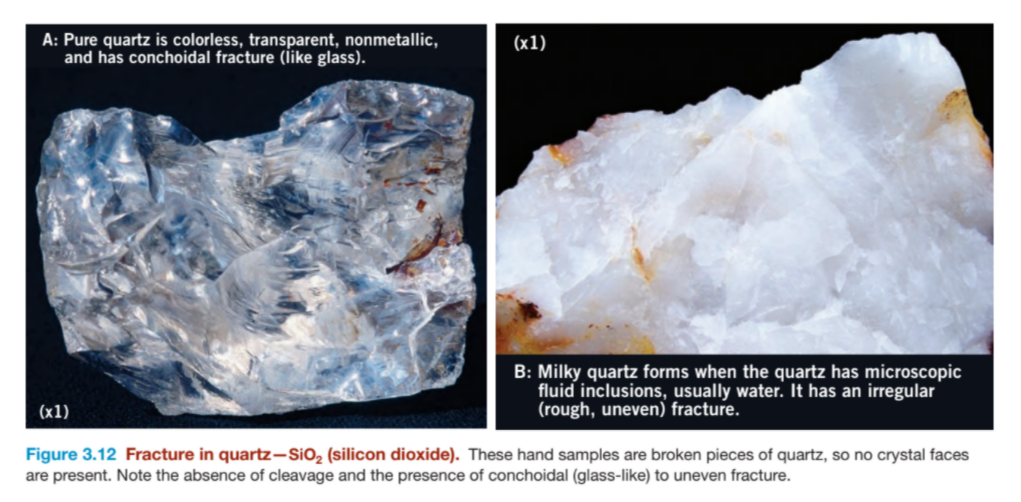
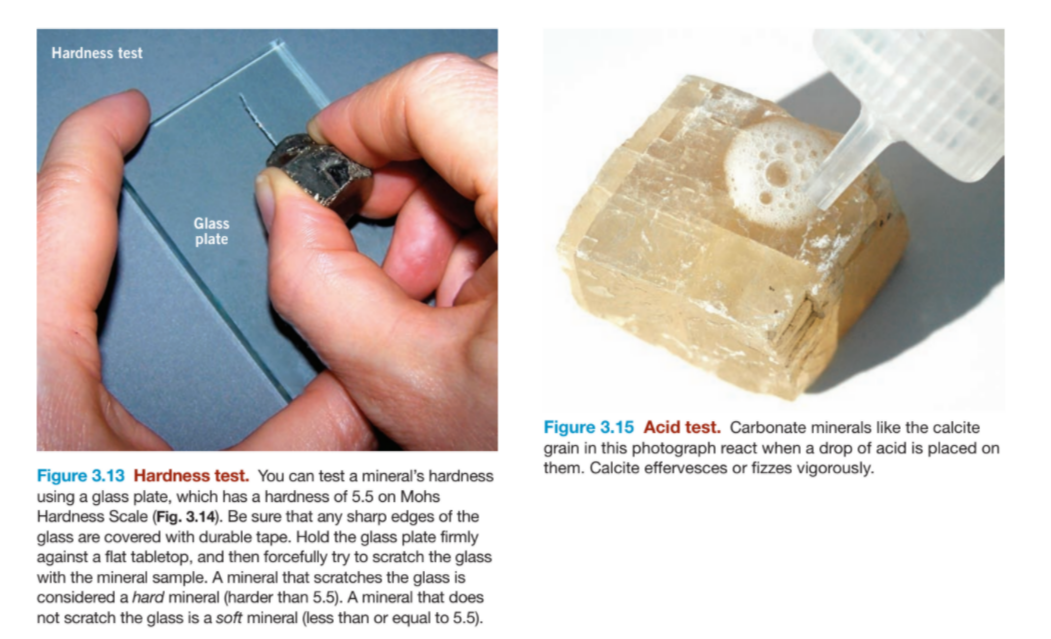
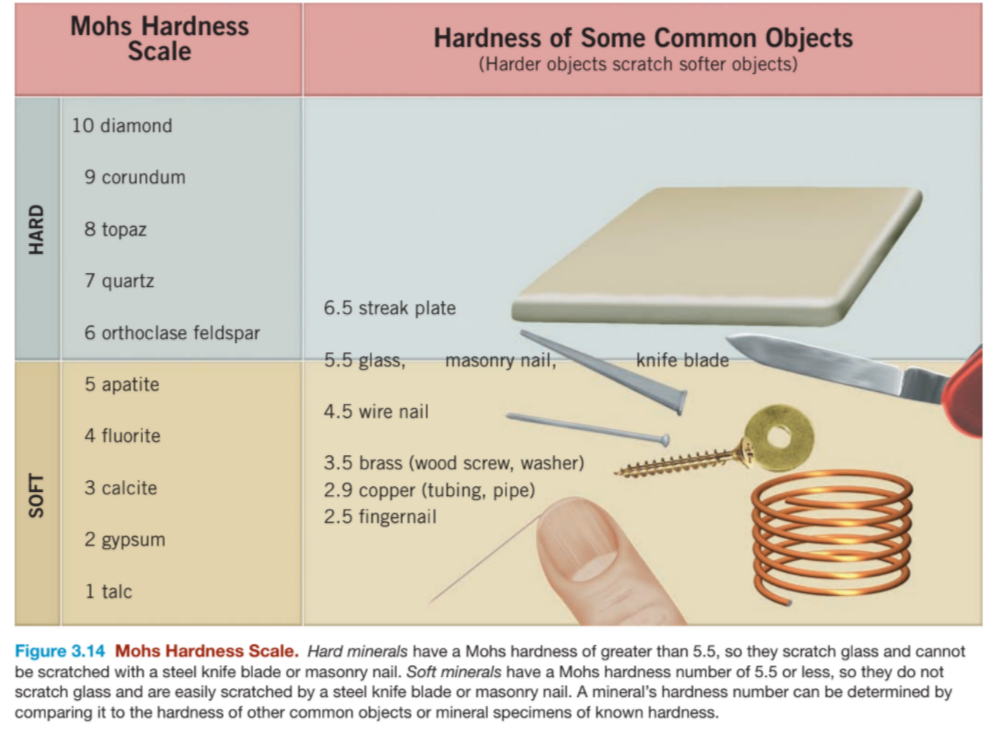
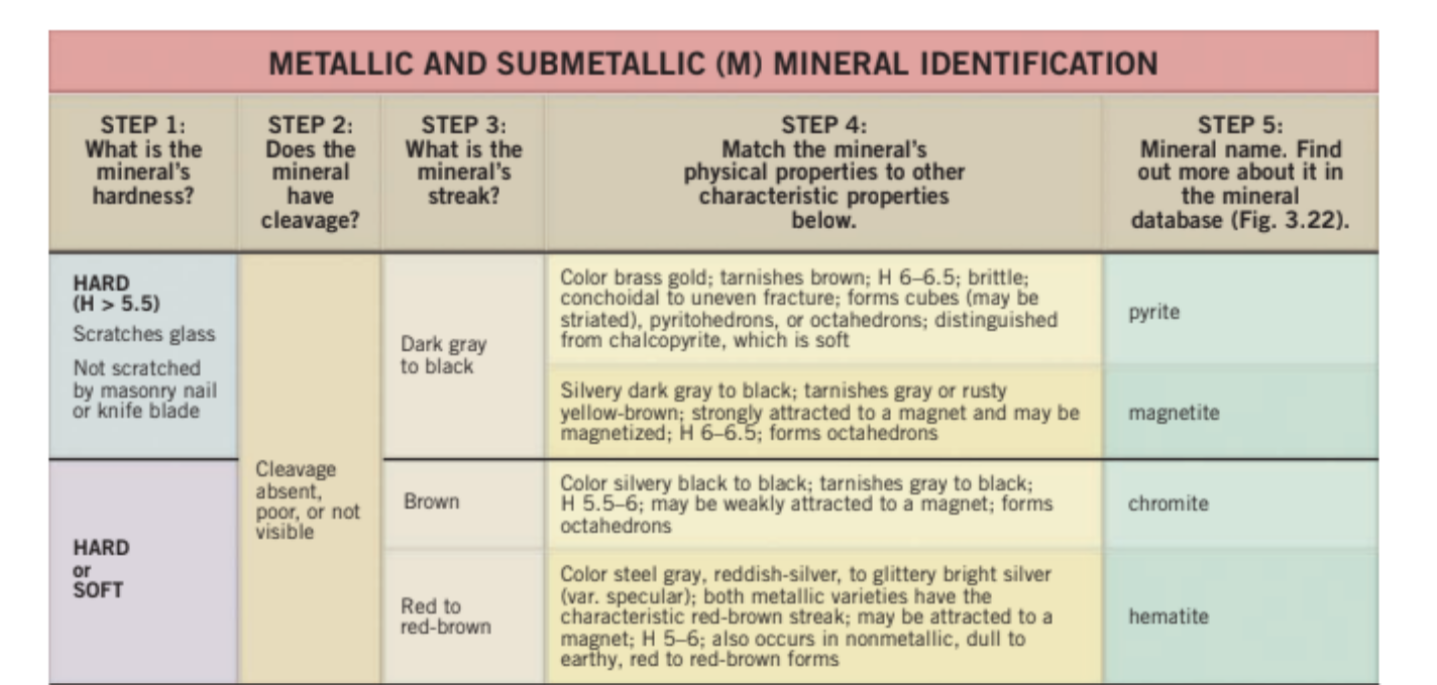
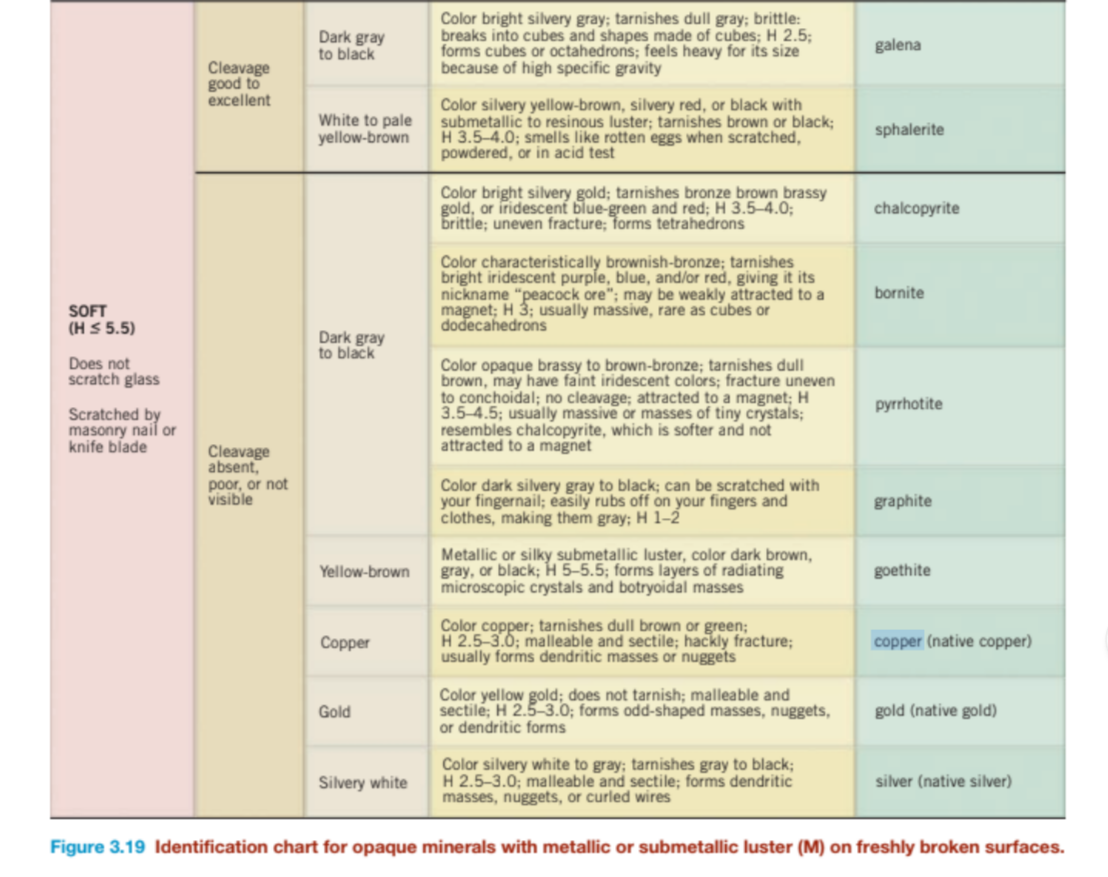
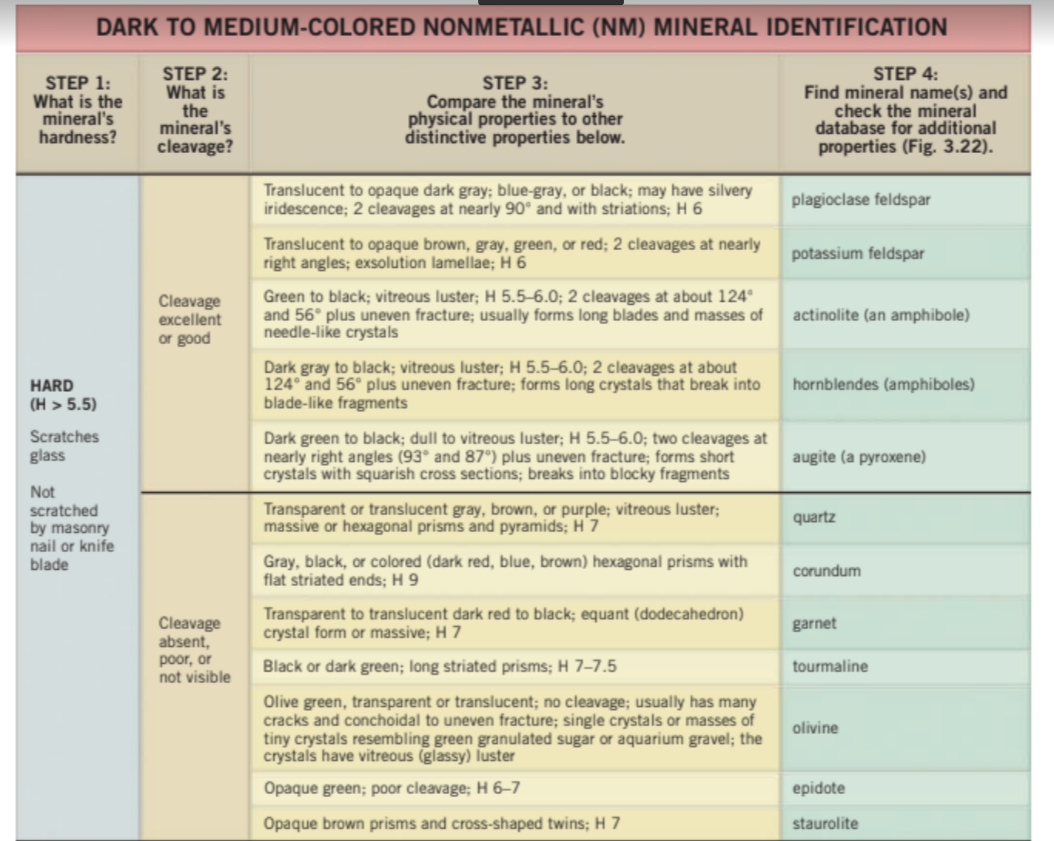
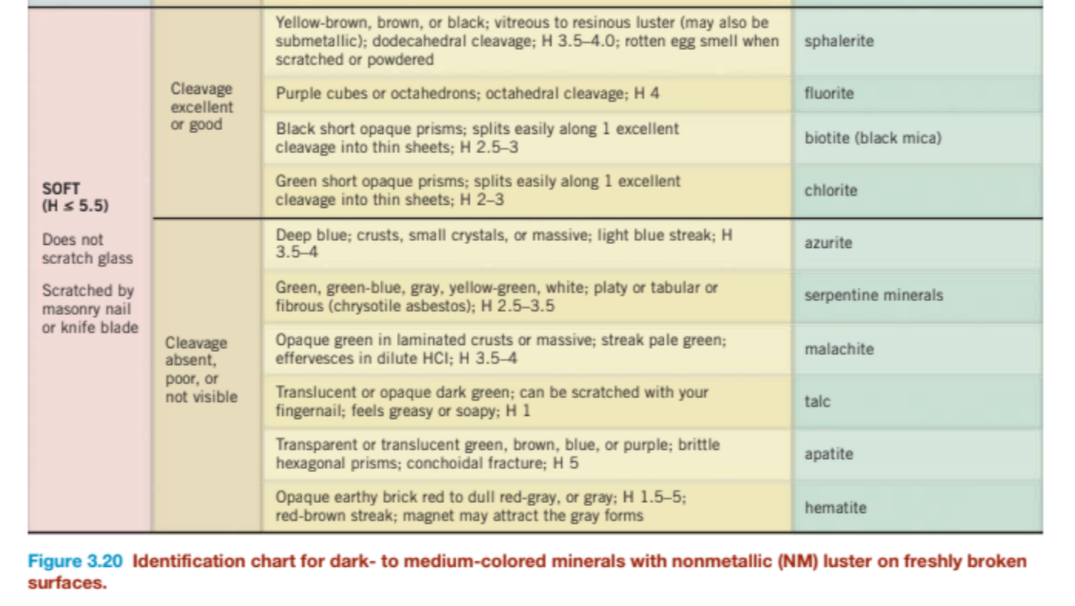
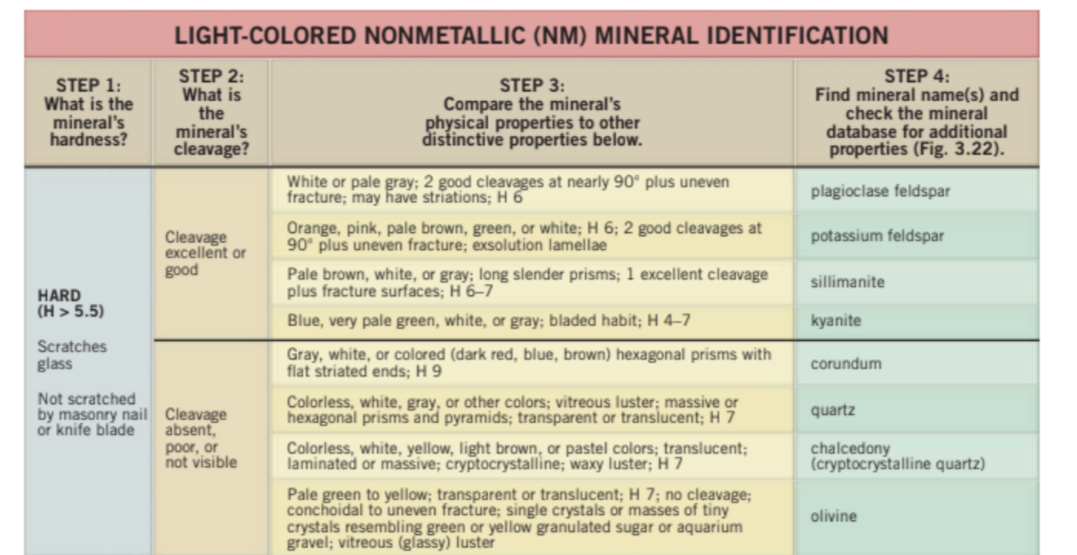
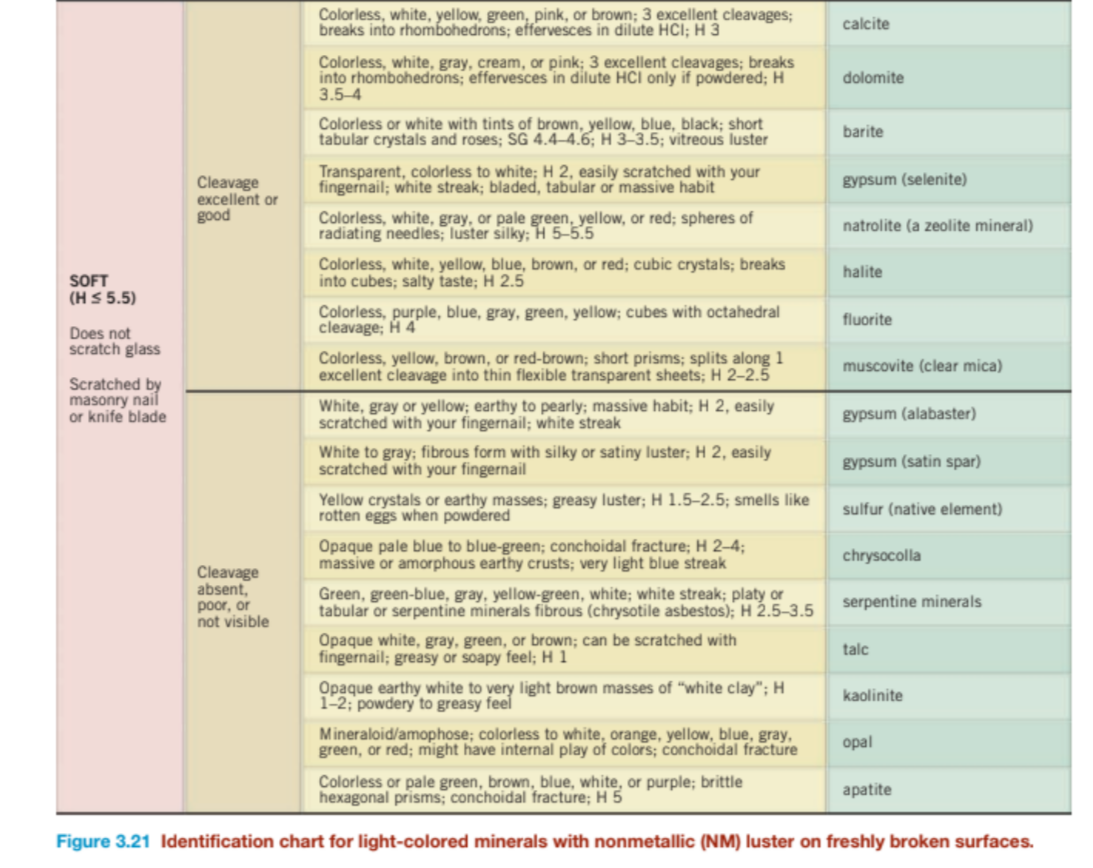

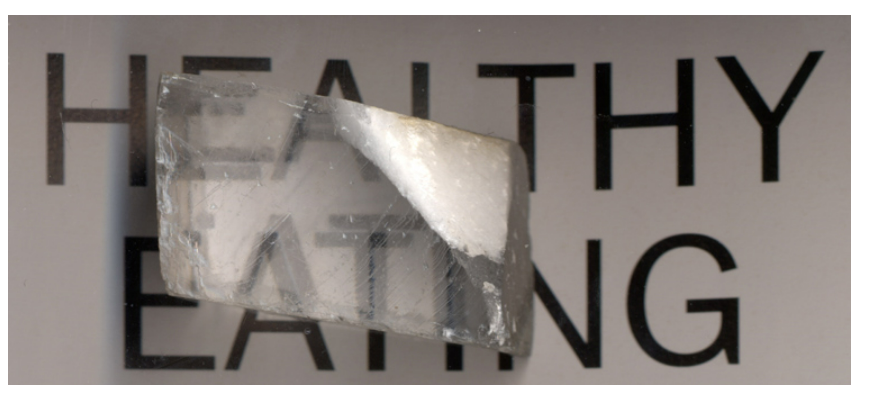
Luster The appearance of a mineral's surface in reflected light is its luster. Light reflects from the outermost surface of a mineral lattice to produce a metallic luster, which has a mirror-like quality. Some of the many examples of minerals with a metallic luster include gold, silver, copper, pyrite, and galena. Metallic minerals are often subject to oxidation, tarnish, or other forms of chemical weathering that might alter their appearance (Fig. 3.4), A Streak plate Color: brassy Streak: dark gray Luster: metallic (M) B Streak plate Color: reddish silver Streak: red-brown Luster: metallic (M) to nonmetallic (NM) Figure 3.3 Streak tests. We determine the streak of soft minerals by scratching them across a streak plate with significant force and then blowing away larger pieces of the mineral to reveal the color of the powder. Streak can also be determined by crushing or scratching part of the sample to see the color of its powdered form. B Maman C Figure 3.4 Fresh versus tarnished metallic minerals. The native elements are minerals composed of just one element, like copper. When freshly formed or broken, native copper has a reflective metallic luster like this freshly minted copper-plated coin (A). However, these dendritic crystals of native copper have tarnished to nonmetallic dull brown (B) and green (C) colors. so determining the luster of these minerals might require you to find (or create) a freshly fractured surface below the altered outer surface. Other minerals have a nonmetallic luster, gener- ally because light can penetrate at least a short distance into the crystal lattice before some of it reflects back out again. Light can pass entirely through some nonmetallic hand specimens and can pass through all nonmetallic specimens if they are thin enough. Geologists use special microscopes to look at mineral and rock specimens that are ground to a thickness of just 0.03 mm (30 millionths of a meter). These carefully ground slices of minerals and rocks are mounted on glass slides and are called thin sections. There are many additional optical proper- ties of nonmetallic minerals that can be observed using a geologist's petrographic microscope to examine thin sections. A luster that seems intermediate between "metallic" and "nonmetallic" is called a submetallic luster. Tarnish or oxidation on a metallic mineral might impart a submetal- lic luster, like rust on a piece of steel. Several other terms are used to describe the luster of nonmetallic specimens, including the following: Vitreous-resembles the luster or sheen of glass Resinous resembles a resin like amber or dried tree sap Silky-a silk-like reflection of light from thin parallel mineral fibers Pearly-resembling the luster of a pearl Earthy (dull)-lacking reflection, like dry soil Waxy-resembles wax Satin-resembles satin cloth Greasy-looks like it is covered in a thin film of oil or grease Cleavage surface Notice how this muscovite mica splits apart into thin, transparent, flexible sheets along its excellent cleavage surfaces Cleavage surface Figure 3.8 Cleavage in mica. The mica group of silicate minerals form lamellar-tabular crystals with one excellent cleavage direction. The crystals split easily into thin sheets, like pages of a book. Muscovite mica is usually clear to silvery brown in color. Biotite mica is black. A. Cleavage excellent or perfect (large, parallel, flat surfaces) Light rays B. Cleavage good or imperfect (small, parallel, flat, stair-like surfaces) Light rays C. Cleavage poor (a few small, flat surfaces difficult to detect) Light rays D. Fractures (broken surfaces lacking cleavage planes) Light rays Conchoidal: Uneven: Hackly: breaks along rough irregular jagged fracture surfaces like surfaces broken metal smooth curved fracture surfaces, like glass Splintery: Fibrous: splinters like wood separates into soft fibers, like cloth Figure 3.9 Recognizing cleavage and fracture. Cross- sections showing how cleavage quality is described. Fracture refers to any break in a mineral that does not occur along a cleavage plane. Therefore, fracture surfaces are normally not flat and don't necessarily occur in parallel sets. Cleavage surface Cleavage surface Fracture surface 124 93 Fracture surface 877 A: Like other pyroxenes, augite has two prominent cleavage directions that intersect at nearly right angles (~87 and -93). Pyroxenes form tetragonal prisms that break into blocky fragments. Cleavage surface Cleavage surface Crystal Crystal fragment 56 Crystal Crystal fragment B: Like other amphiboles, hornblendes have two prominent cleavage directions that intersect at angles of -56 and -124. Their crystals are blade-like 6-sided prisms that break into bladed fragments. Figure 3.10 Cleavage in pyroxenes and amphiboles. Pyroxenes and amphiboles are two groups of dark-colored silicate minerals with many similar properties. The main feature that distinguishes them in hand sample is the geometry of their two prominent cleavage directions. Plagioclase 94 93 pyroxenes (augite) 87 94 plagioclase feldspar 86 Fracture surfaces 86 Cleavage planes with no striations Cleavage plane with parallel, closely spaced striations PRISMATIC orthoclase (K-feldspar) Pink K-feldspar (orthoclase) 90 90 Right-angle cleavage Right-angle cleavage 606 1 ) Cleavage plane with subparallel color variation bands from exsolution lamellae 90 B. Pink K-feldspar (orthoclase) MATIC Cleavage plane with parallel, closely spaced striations orthoclase (K-feldspar) 90 White K-feldspar (orthoclase) Fracture surfaces at broken ends of crystals Cleavage surface with striations A. Plagioclase C. Rock comprised of plagioclase crystals Figure 3.11 Common feldspars. Note how the cleavage goniometer can be used to distinguish potassium feldspar (K-spar, orthoclase) from plagioclase. Orthoclase (Greek, ortho-right angle and clase-break) has perfect right-angle (90) cleavage. Plagioclase (Greek, plagio-oblique angle and clase-break) does not. A. Plagioclase often exhibits hairline striations on some of its cleavage surfaces. They are caused by polysynthetic twinning. B. Orthoclase specimens may have intergrowths of thin, discontinuous, exsolution lamellae. They are alternating irregular layers of sodium feldspar and potassium feldspar. C. Hand sample of a rock that is an aggregate of intergrown plagioclase grains. Individual mineral grains are discernible within the rock, particularly the cleavage surfaces that have characteristic hairline striations. A: Pure quartz is colorless, transparent, nonmetallic, and has conchoidal fracture (like glass). (x1) B: Milky quartz forms when the quartz has microscopic fluid inclusions, usually water. It has an irregular (rough, uneven) fracture. (x1) Figure 3.12 Fracture in quartz-SiO (silicon dioxide). These hand samples are broken pieces of quartz, so no crystal faces are present. Note the absence of cleavage and the presence of conchoidal (glass-like) to uneven fracture. Hardness test Glass plate Figure 3.13 Hardness test. You can test a mineral's hardness using a glass plate, which has a hardness of 5.5 on Mohs Hardness Scale (Fig. 3.14). Be sure that any sharp edges of the glass are covered with durable tape. Hold the glass plate firmly against a flat tabletop, and then forcefully try to scratch the glass with the mineral sample. A mineral that scratches the glass is considered a hard mineral (harder than 5.5). A mineral that does not scratch the glass is a soft mineral (less than or equal to 5.5). Figure 3.15 Acid test. Carbonate minerals like the calcite grain in this photograph react when a drop of acid is placed on them. Calcite effervesces or fizzes vigorously. HARD SOFT Mohs Hardness Scale 10 diamond 9 corundum 8 topaz 7 quartz 6 orthoclase feldspar 5 apatite 4 fluorite 3 calcite 2 gypsum 1 talc Hardness of Some Common Objects (Harder objects scratch softer objects) 6.5 streak plate 5.5 glass, 4.5 wire nail masonry nail, 3.5 brass (wood screw, washer) 2.9 copper (tubing, pipe) 2.5 fingernail knife blade Figure 3.14 Mohs Hardness Scale. Hard minerals have a Mohs hardness of greater than 5.5, so they scratch glass and cannot be scratched with a steel knife blade or masonry nail. Soft minerals have a Mohs hardness number of 5.5 or less, so they do not scratch glass and are easily scratched by a steel knife blade or masonry nail. A mineral's hardness number can be determined by comparing it to the hardness of other common objects or mineral specimens of known hardness. STEP 1: What is the mineral's hardness? HARD (H> 5.5) Scratches glass Not scratched by masonry nail or knife blade HARD or SOFT METALLIC AND SUBMETALLIC (M) MINERAL IDENTIFICATION STEP 2: STEP 4: Does the mineral have cleavage? STEP 3: What is the mineral's streak? Match the mineral's physical properties to other characteristic properties below. Cleavage absent, poor, or not visible Dark gray to black Brown Red to red-brown Color brass gold; tarnishes brown; H 6-6.5; brittle; conchoidal to uneven fracture; forms cubes (may be striated), pyritohedrons, or octahedrons; distinguished from chalcopyrite, which is soft Silvery dark gray to black; tarnishes gray or rusty yellow-brown; strongly attracted to a magnet and may be magnetized; H 6-6.5; forms octahedrons Color silvery black to black; tarnishes gray to black; H 5.5-6; may be weakly attracted to a magnet; forms octahedrons Color steel gray, reddish-silver, to glittery bright silver (var. specular); both metallic varieties have the characteristic red-brown streak; may be attracted to a magnet; H 5-6; also occurs in nonmetallic, dull to earthy, red to red-brown forms STEP 5: Mineral name. Find out more about it in the mineral database (Fig. 3.22). pyrite magnetite chromite hematite SOFT (H 5.5) Does not scratch glass Scratched by masonry nail or knife blade Cleavage good to excellent Cleavage absent, poor, or not visible Dark gray to black White to pale yellow-brown Dark gray to black Yellow-brown Copper Gold Color bright silvery gray; tarnishes dull gray; brittle: breaks into cubes and shapes made of cubes; H 2.5; forms cubes or octahedrons; feels heavy for its size because of high specific gravity Silvery white Color silvery yellow-brown, silvery red, or black with submetallic to resinous luster; tarnishes brown or black; H 3.5-4.0; smells like rotten eggs when scratched, powdered, or in acid test Color bright silvery gold; tarnishes bronze brown brassy gold, or iridescent blue-green and red; H 3.5-4.0; brittle; uneven fracture; forms tetrahedrons Color characteristically brownish-bronze; tarnishes bright iridescent purple, blue, and/or red, giving it its nickname "peacock ore"; may be weakly attracted to a magnet; H 3; usually massive, rare as cubes or dodecahedrons Color opaque brassy to brown-bronze; tarnishes dull brown, may have faint iridescent colors; fracture uneven to conchoidal; no cleavage; attracted to a magnet; H 3.5-4.5; usually massive or masses of tiny crystals; resembles chalcopyrite, which is softer and not attracted to a magnet Color dark silvery gray to black; can be scratched with your fingernail; easily rubs off on your fingers and clothes, making them gray; H 1-2 Metallic or silky submetallic luster, color dark brown, gray, or black; H 5-5.5; forms layers of radiating microscopic crystals and botryoidal masses Color copper; tarnishes dull brown or green; H 2.5-3.0; malleable and sectile; hackly fracture; usually forms dendritic masses or nuggets Color yellow gold; does not tarnish; malleable and sectile; H 2.5-3.0; forms odd-shaped masses, nuggets, or dendritic forms galena sphalerite chalcopyrite bornite pyrrhotite graphite goethite copper (native copper) gold (native gold) Color silvery white to gray; tarnishes gray to black; H 2.5-3.0; malleable and sectile; forms dendritic masses, nuggets, or curled wires Figure 3.19 Identification chart for opaque minerals with metallic or submetallic luster (M) on freshly broken surfaces. silver (native silver) DARK TO MEDIUM-COLORED NONMETALLIC (NM) MINERAL IDENTIFICATION STEP 2: What is STEP 1: What is the mineral's hardness? HARD (H> 5.5) Scratches glass Not scratched by masonry nail or knife blade the mineral's cleavage? Cleavage excellent or good Cleavage absent, poor, or not visible STEP 3: Compare the mineral's physical properties to other distinctive properties below. Translucent to opaque dark gray; blue-gray, or black; may have silvery iridescence; 2 cleavages at nearly 90 and with striations; H 6 Translucent to opaque brown, gray, green, or red; 2 cleavages at nearly right angles; exsolution lamellae; H 6 Green to black; vitreous luster; H 5.5-6.0; 2 cleavages at about 124 and 56 plus uneven fracture; usually forms long blades and masses of needle-like crystals Dark gray to black; vitreous luster; H 5.5-6.0; 2 cleavages at about 124 and 56 plus uneven fracture; forms long crystals that break into blade-like fragments Dark green to black; dull to vitreous luster; H 5.5-6.0; two cleavages at nearly right angles (93 and 87) plus uneven fracture; forms short crystals with squarish cross sections; breaks into blocky fragments Transparent or translucent gray, brown, or purple; vitreous luster; massive or hexagonal prisms and pyramids; H 7 Gray, black, or colored (dark red, blue, brown) hexagonal prisms with flat striated ends; H 9 Transparent to translucent dark red to black; equant (dodecahedron) crystal form or massive; H 7 Black or dark green; long striated prisms; H 7-7.5 Olive green, transparent or translucent; no cleavage; usually has many cracks and conchoidal to uneven fracture; single crystals or masses of tiny crystals resembling green granulated sugar or aquarium gravel; the crystals have vitreous (glassy) luster Opaque green; poor cleavage; H 6-7 Opaque brown prisms and cross-shaped twins; H 7 STEP 4: Find mineral name(s) and check the mineral database for additional properties (Fig. 3.22). plagioclase feldspar potassium feldspar actinolite (an amphibole) hornblendes (amphiboles) augite (a pyroxene) quartz corundum garnet tourmaline olivine epidote staurolite SOFT (H 5.5) Does not scratch glass Scratched by masonry nail or knife blade Cleavage excellent or good Cleavage absent, poor, or not visible Yellow-brown, brown, or black; vitreous to resinous luster (may also be submetallic); dodecahedral cleavage; H 3.5-4.0; rotten egg smell when scratched or powdered Purple cubes or octahedrons; octahedral cleavage; H4 Black short opaque prisms; splits easily along 1 excellent cleavage into thin sheets; H 2.5-3 Green short opaque prisms; splits easily along 1 excellent cleavage into thin sheets; H 2-3 Deep blue; crusts, small crystals, or massive; light blue streak; H 3.5-4 Green, green-blue, gray, yellow-green, white; platy or tabular or fibrous (chrysotile asbestos); H 2.5-3.5 Opaque green in laminated crusts or massive; streak pale green; effervesces in dilute HCI; H 3.5-4 Translucent or opaque dark green; can be scratched with your fingernail; feels greasy or soapy; H 1 Transparent or translucent green, brown, blue, or purple; brittle hexagonal prisms; conchoidal fracture; H 5 Opaque earthy brick red to dull red-gray, or gray; H 1.5-5; red-brown streak; magnet may attract the gray forms sphalerite fluorite biotite (black mica) chlorite azurite serpentine minerals malachite talc apatite hematite Figure 3.20 Identification chart for dark- to medium-colored minerals with nonmetallic (NM) luster on freshly broken surfaces. STEP 1: What is the mineral's hardness? HARD (H> 5.5) Scratches glass Not scratched by masonry nail or knife blade LIGHT-COLORED NONMETALLIC (NM) MINERAL IDENTIFICATION STEP 2: What is STEP 3: Compare the mineral's physical properties to other distinctive properties below. the mineral's cleavage? Cleavage excellent or good Cleavage absent, poor, or ible White or pale gray; 2 good cleavages at nearly 90 plus uneven fracture; may have striations; H6 Orange, pink, pale brown, green, or white; H 6; 2 good cleavages at 90 plus uneven fracture; exsolution lamellae Pale brown, white, or gray; long slender prisms; 1 excellent cleavage plus fracture surfaces; H 6-7 Blue, very pale green, white, or gray; bladed habit; H 4-7 Gray, white, or colored (dark red, blue, brown) hexagonal prisms with flat striated ends; H 9 Colorless, white, gray, or other colors; vitreous luster; massive or hexagonal prisms and pyramids; transparent or translucent; H 7 Colorless, white, yellow, light brown, or pastel colors; translucent; laminated or massive; cryptocrystalline; waxy luster; H 7 Pale green to yellow; transparent or translucent; H 7; no cleavage; conchoidal to uneven fracture; single crystals or masses of tiny crystals resembling green or yellow granulated sugar or aquarium gravel; vitreous (glassy) luster STEP 4: Find mineral name(s) and check the mineral database for additional properties (Fig. 3.22). plagioclase feldspar potassium feldspar sillimanite kyanite corundum quartz chalcedony (cryptocrystalline quartz) olivine SOFT (H 5.5) Does not scratch glass Scratched by masonry nail or knife blade Cleavage excellent or good Cleavage absent, poor, or not visible Colorless, white, yellow, green, pink, or brown; 3 excellent cleavages; breaks into rhombohedrons; effervesces in dilute HCI; H 3 Colorless, white, gray, cream, or pink; 3 excellent cleavages; breaks into rhombohedrons; effervesces in dilute HCI only if powdered; H 3.5-4 Colorless or white with tints of brown, yellow, blue, black; short tabular crystals and roses; SG 4.4-4.6; H 3-3.5; vitreous luster Transparent, colorless to white; H 2, easily scratched with your fingernail; white streak; bladed, tabular or massive habit Colorless, white, gray, or pale green, yellow, or red; spheres of radiating needles; luster silky; H 5-5.5 Colorless, white, yellow, blue, brown, or red; cubic crystals; breaks into cubes; salty taste; H 2.5 Colorless, purple, blue, gray, green, yellow; cubes with octahedral cleavage; H 4 Colorless, yellow, brown, or red-brown; short prisms; splits along 1 excellent cleavage into thin flexible transparent sheets; H 2-2.5 White, gray or yellow; earthy to pearly; massive habit; H 2, easily scratched with your fingernail; white streak White to gray; fibrous form with silky or satiny luster; H 2, easily scratched with your fingernail Yellow crystals or earthy masses; greasy luster; H 1.5-2.5; smells like rotten eggs when powdered Opaque pale blue to blue-green; conchoidal fracture; H 2-4; massive or amorphous earthy crusts; very light blue streak Green, green-blue, gray, yellow-green, white; white streak; platy or tabular or serpentine minerals fibrous (chrysotile asbestos); H 2.5-3.5 Opaque white, gray, green, or brown; can be scratched with fingernail; greasy or soapy feel; H 1 Opaque earthy white to very light brown masses of "white clay"; H 1-2; powdery to greasy feel Mineraloid/amophose; colorless to white, orange, yellow, blue, gray, green, or red; might have internal play of colors; conchoidal fracture calcite dolomite barite gypsum (selenite) natrolite (a zeolite mineral) halite fluorite muscovite (clear mica) gypsum (alabaster) gypsum (satin spar) sulfur (native element) chrysocolla serpentine minerals talc kaolinite opal Colorless or pale green, brown, blue, white, or purple; brittle hexagonal prisms; conchoidal fracture; H 5 Figure 3.21 Identification chart for light-colored minerals with nonmetallic (NM) luster on freshly broken surfaces. apatite Important Instructions: Answer this question using your own words. Answer each component of this question (i, ii, iii, and iv) in separate paragraphs. Use 4 to 5 sentences for each paragraph. Type your answer in the space provided. This is not a group assignment. You need to write the answers on your own. If the same answer is submitted by more than one student, a grade of zero will be awarded. Questions i. Explain in 4 to 5 sentences and in your own words how the discussion of "Luster" on Page #74-75 of your lab manual can be used to classify the luster of unknown mineral samples. ii. Explain in 4 to 5 sentences and in your own words how the discussion of "Hardness" on Pages # 78-81 and Figure 3.14 on PAGE 81 can be used to classify the hardness of unknown mineral samples. iii. The charts on the pages 85-87 of your lab manual delineate the name identification procedure of unknown mineral samples. More specifically the tables presents steps one can follow in order to classify unknown mineral samples and to identify their names. Explain these steps in 4 to 5 sentences and in your own words. 1. Page 85 of your lab manual: Metallic and Submetallic mineral identification 2. Page 86 of your lab manual: Dark to Medium-colored nonmetallic mineral identification 3. Page 87 of your lab manual: Light-colored nonmetallic mineral identification iv. The mineral in the following image does not scratch glass plate. This particular mineral is harder than human fingernail. This mineral readily reacts (effervesces/bubles) with dilute hydrochloric acid (HCI). Using this mineral as an example, describe the procedure you will employ in using one of the above mentioned three pages (pages 85 or 86 or 87). Include the following in your answer. 1. Which chart, page 85 or 86 or 87, will you use for this mineral sample? Why? 2. Which physical property will you use to complete the Step 1? What is the result? 3. Which physical properties will you use to complete the next few Steps? What are the results? 4. What is the name of this mineral? Why? HEALTHY EATING
Step by Step Solution
There are 3 Steps involved in it
Step: 1

Get Instant Access to Expert-Tailored Solutions
See step-by-step solutions with expert insights and AI powered tools for academic success
Step: 2

Step: 3

Ace Your Homework with AI
Get the answers you need in no time with our AI-driven, step-by-step assistance
Get Started


